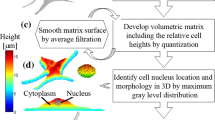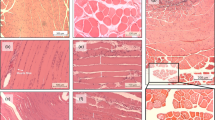Abstract
Skeletal muscle cells are sensitive to sustained compression, which can lead to the development of pressure sores. Although it is known that this type of tissue breakdown depends on the magnitude and duration of the applied load, the exact relationship between cell deformation and damage remains unclear. To gain more insight into this process, a method has been developed, that incorporates the use of a new loading device and confocal microscopy. The loading device is able to compress individual cells, either statically or dynamically, while measuring the resulting forces. Experiments can be performed under ideal environmental conditions, comparable with those of a CO2 incubator. First compression experiments on C2C12 mouse myoblasts showed the shape changes that cells undergo during static compression by the loading device. Calculations using the three-dimensional confocal images showed no change in volume and an increase in the surface area of the cell as a result of compression. The device presented here provides a useful way to monitor the biomechanical response of skeletal muscle cells during long-term compression experiments. Therefore it will contribute to the knowledge about strain-induced cell damage, as seen in pressure sores and other mechanically induced clinical conditions.
Similar content being viewed by others
References
Barbenel, J. C. (1991): ‘Pressure management’,Prosthet. Orthot. Int.,15, pp. 225–231
Bluhm, W. F., McCulloch, A. D., andLew, W. Y. W. (1995): ‘Active force in rabbit ventricular myocytes’,J. Biomech.,9, pp. 1119–1122
Bouten, C. V. C., Bosboom, E. M. H., andOomens, C. W. J. (1999): ‘The aetiology of pressure sores: a tissue and cell mechanics approach’, invan der Woude, L. H. V. (Ed.): ‘Biomedical aspects of manual wheelchair propulsion, Assistive technology research series, vol. 5’ (IOS, Amsterdam, 1999), pp. 52–62
Bouten, C. V. C., Knight, M. M., Lee, D. A., andBader, D. L. (2001): ‘Compressive deformation and damage of muscle cell subpopulations in a model system’,Ann. Biomed. Eng.,29, pp. 153–163
Brown, T. D. (2000): ‘Techniques for mechanical stimulation of cellsin vitro: a review’,J. Biomech.,33, pp. 3–14
Caille, N., Thoumine, O., Tardy, Y., andMeister, J.-J. (2002): ‘Contribution of the nucleus to the mechanical properties of endothelial cells’,J. Biomech.,35, pp. 177–187
Caplan, A., Carlson, B., Faulkner, J., Fischman, D., andGarett, W. (1988): ‘Skeletal muscle’, inWoo, S.L.-Y., andBuckwalter, J. A., (Eds.). Injury and repair of the musculoskeletal soft tissues’ (American Academy of Orthopaedic Surgeons, Park Ridge, 1988), pp. 213–291
Chen, C. S., andIngber, D. E. (1999): ‘Tensegrity and mechanoregulation: from skeleton to cytoskeleton’,Osteoarthrit. Cartil.,7, pp. 81–94
Cubitt, A. B., Heim, R., Adams, S. R., Boyd, A. E., Gross, L. A., andTsien, R. Y. (1995): ‘Understanding, improving and using green fluorescent proteins’,Trends Biochem. Sci.,20, pp. 448–455
Daniel, R. K., Priest, D. L., andWheatley, D. C. (1982): ‘Etiologic factors in pressure sores: An experimental model’,Med. Rehabil.,62, pp. 492–498
Davies, P. F., andTripathi, S. C. (1993): ‘Mechanical stress mechanisms and the cell: an endothelial paradigm’,Circ. Res.,72, pp. 239–245
Dong, C., Skalak, R., Sung, K., Schmid-Schönbein, G., andChien, S. (1988): ‘Passive deformation analysis human leukocytes’,J. Biomech. Eng.,110, pp. 27–36
Elson, E. (1988): ‘Cellular mechanics as an indicator of cytoskeletal structure and function’,Ann. Rev. Biophys. Biophys. Chem.,17, 397–430
Folch, A., andToner, M. (2000): ‘Microengineering of cellular interactions’,Ann. Rev. Biomed. Eng.,2, pp. 227–256
Frangos, J. (1993): ‘Physical forces and the mammalian cell’ (Academic Press, London, 1993)
Galbraith, C. G., Skalak, R., andChien, S. (1998): ‘Shear stress induces spatial reorganization of the endothelial cell cytoskeleton’,Cell Motil. Cytoskeleton,40, pp. 317–330
Guilak, F. (1995): ‘Compression-induced changes in the shape and volume of the chondrocyte nucleus’,J. Biomech.,28, pp. 1529–1541
Haga, H., Sasaki, S., Kawabata, K., Ito, E., Ushiki, T., andSambongi, T. (2000): ‘Elasticity mapping of living fibroblasts by AFM and immunofluorescence observation of the cytoskeleton’,Ultramicr.,82, pp. 253–258
Ingber, D. E. (1997): ‘Tensegrity: the architectural basis of cellular mechanotransduction’,Ann. Rev. Physiol.,59, pp. 575–599
Komuro, I., Katoh, Y., Kaida, T., Shibazaki, Y., Kurabayashi, M., Hoh, E., Takaku, F., andYazaki, Y. (1991): ‘Mechanical loading stimulates cell hypertrophy and specific gene expression in cultured rat cardiac myocytes’,J. Biol. Chem.,266, pp. 1265–1268
Krouskop, T. A. (1983): ‘A synthesis of the factors that contribute to pressure sore formation’,Med. Hyp.,11, pp. 255–267
McMahon, D. K., Anderson, P. A. W., Nassar, R., Bunting, J. B., Saba, Z., Oakeley, A. E., andMalouf, N. N. (1994): ‘C2C12 cells: biophysical, biochemical, and immunocytochemical properties’,Am. J. Physiol.,266, pp. C1795–1802
Moore, S. W. (1994): ‘A fiber optic system for measuring dynamic mechanical properties of embryonic tissues’,IEEE Trans. Biomed. Eng.,41, pp. 45–50
Nola, G. T., andVistnes, L. M. (1980): ‘Differential response of skin and muscle in the experimental production of pressure sores’,Plast. Reconst. Surg.,66, pp. 728–733
Petersen, N. O., McConnaughey, W. B., andElson, E. L. (1982): ‘Dependence of locally measured cellular deformability on position on the cell, temperature, and cytochalasin B’,Cell Biol.,79, pp. 5327–5331
Ra, H. J., Picart, C., Feng, H., Sweeney, H. L., andDischer, D. E. (1999): ‘Muscle cell peeling from micropatterned collagen: direct probing of focal and molecular properties of matrix adhesion’,J. Cell Sci.,112, pp. 1425–1436
Sato, M., Theret, D. P., Wheeler, L. T., Ohshima, N., andNerem, R. M. (1990): ‘Application of the micropipette technique of the measurement of cultured porcine aortic endothelial cell viscoelastic properties’,J. Biomech. Eng.,112, pp. 263–268
Thoumine, O., Ott, A., Cardoso, O., Meister, J.-J. (1999a): ‘Microplates: a new tool for manipulation and mechanical perturbation individual cells’,J. Biochem. Biophys. Methods,39, pp. 47–62
Thoumine, O., Cardoso, O., andMeister, J.-J. (1999b): ‘Changes in the mechanical properties of fibroblasts during spreading: a micromanipulation study’,Eur. Biophys. J.,28, pp. 222–234
Vandenburgh, H. (1992): ‘Mechanical forces and their second messengers in stimulating cell growthin vitro’,Am. J. Physiol.,262, R350-R355
Wang, N., Butler, J., andInber, D. E. (1993): ‘Mechanotransduction across the cell surface and through the cytoskeleton’,Science,260, pp. 1124–1127
Yoshikawa, Y., Yasuike, T., Yagi, A., andYamada, T. (1999): ‘Transverse elasticity of myofibrils of rabbit skeletal muscle studied by atomic force microscopy’,256, pp. 13–19
Zhang, Z., Fernczi, M., Lush, A., andThomas, C. (1991): ‘A novel micromanipulation technique for measuring the bursting strength of single mammalian cells’,Appl. Microbiol. Biotech.,36, pp. 208–210
Zhu, C., Bao, G., andWang, N. (2000): ‘Cell mechanics: mechanical response, cell adhesion, and molecular deformation’,Ann. Rev. Biomed. Eng.,2, pp. 189–226
Author information
Authors and Affiliations
Corresponding author
Rights and permissions
About this article
Cite this article
Peeters, E.A.G., Bouten, C.V.C., Oomens, C.W.J. et al. Monitoring the biomechanical response of individual cells under compression: A new compression device. Med. Biol. Eng. Comput. 41, 498–503 (2003). https://doi.org/10.1007/BF02348096
Received:
Accepted:
Issue Date:
DOI: https://doi.org/10.1007/BF02348096




